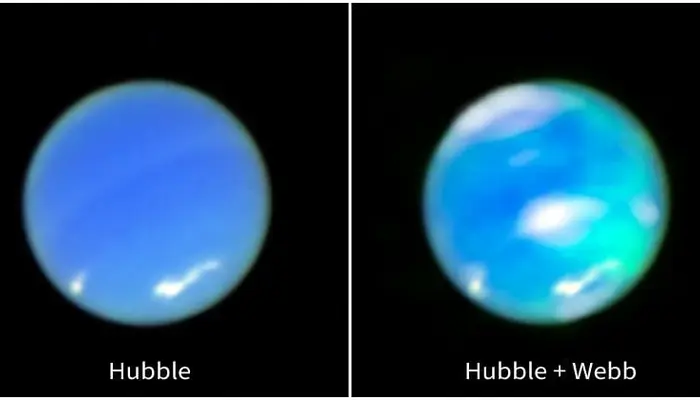James Webb Telescope Captures Stunning Auroras on Neptune

The James Webb Space Telescope (JWST) has provided the first direct evidence of auroras on Neptune, revealing a breathtaking display of light in the planet’s atmosphere. Using its advanced near-infrared sensitivity, JWST captured detailed images of Neptune’s auroras, a phenomenon never directly observed before. These findings, combined with data from the Hubble Space Telescope, shed new light on the mysterious magnetic field of our solar system’s most distant ice giant.
A First for Neptune
Auroras occur when energetic particles from the Sun become trapped in a planet’s magnetic field and collide with the upper atmosphere, creating a glowing effect. While this process has been well-documented on Jupiter, Saturn, and Uranus, Neptune’s auroras had only been hinted at during NASA’s Voyager 2 flyby in 1989. Until now, scientists lacked the necessary tools to capture them with clarity.
Henrik Melin from Northumbria University described the discovery as “stunning,” noting that JWST’s powerful near-infrared spectrograph provided a level of detail never seen before. The auroras appear as bright cyan regions in the images, set against Neptune’s deep blue atmosphere and swirling white clouds.
Why Are Neptune’s Auroras Different?
Unlike Earth, where auroras mostly appear at the poles, Neptune’s auroras occur at various locations. This unusual pattern is due to the planet’s magnetic field, which is tilted 47 degrees from its rotational axis. As a result, the interaction between the solar wind and Neptune’s atmosphere creates auroral displays in unexpected regions.
Scientists also detected emissions from trihydrogen cation (H3+), a molecule formed in auroral activity. This provides crucial insights into Neptune’s atmospheric composition and how its magnetosphere interacts with solar radiation.
Read: Saudi Arabia Announces New Health Requirement for Hajj 2025
How the Observations Were Made
JWST’s Near-Infrared Spectrograph (NIRSpec) played a key role in capturing these images. The telescope’s sensitivity to infrared light allowed it to detect the faint glow of auroras that had previously gone unnoticed. Complementary data from Hubble’s Wide Field Camera 3 helped provide a clearer view of Neptune’s atmospheric dynamics.
This discovery marks a significant step in understanding the magnetic fields and atmospheres of ice giants. By studying auroras on different planets, scientists can learn more about space weather, planetary evolution, and how solar radiation influences atmospheres beyond Earth.
A New Era of Discovery
The detection of Neptune’s auroras is just one of many breakthroughs made possible by JWST. As it continues to explore the outer solar system, astronomers anticipate more insights into the planet’s composition, weather patterns, and even its faint rings.
With each new observation, telescopes like JWST and Hubble expand our understanding of the universe. Neptune’s auroras are a reminder of the wonders hidden in our own cosmic backyard, waiting to be uncovered.
Follow us on Google News, Instagram, YouTube, Facebook,Whats App, and TikTok for latest updates












